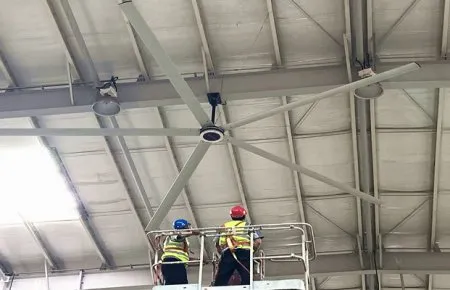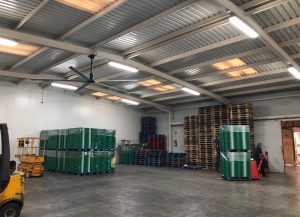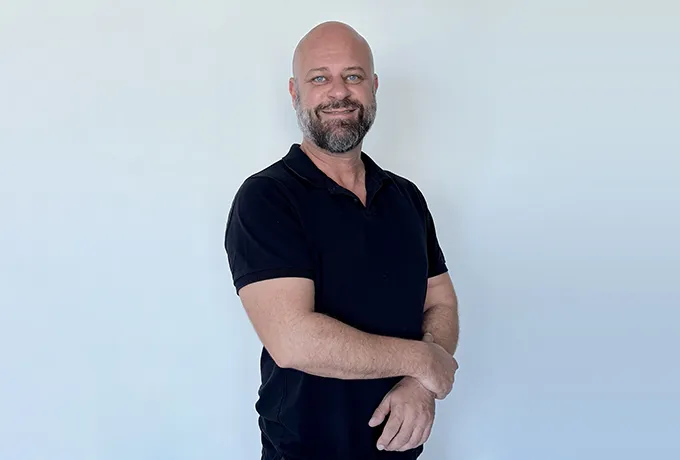Are you struggling with poor air circulation, high energy costs, and uncomfortable working conditions in your large facility? Traditional cooling solutions often fall short, leaving hot spots, stagnant air, and skyrocketing utility bills that impact your bottom line.
HVLS (High-Volume, Low-Speed) fans are industrial-grade ceiling fans specifically engineered to move massive volumes of air while operating at low speeds. These powerful fans, typically ranging from 8 to 24 feet in diameter, can effectively circulate air throughout large spaces using minimal energy, making them ideal for warehouses, factories, and commercial facilities.

HVLS fan installation in warehouse
HVLS fans represent a revolutionary advancement in air movement technology. Unlike conventional industrial fans or residential ceiling fans, HVLS fans are designed with:
The combination of these features allows them to move a high volume of air while consuming significantly less power than multiple smaller fans.
The science behind HVLS fans is fascinating and practical:
Installing HVLS fans offers numerous advantages for commercial and industrial spaces:
HVLS fans are particularly effective in:
🏭 Manufacturing facilities
🏪 Distribution centers
🏫 Educational institutions
🏢 Commercial buildings
🏋️♂️ Fitness centers
🏗️ Construction sites

Logistics of HVLS Fans
Choosing the right size depends on several factors:
recommend: M750 Series HVLS Fans
Real-world energy savings are significant:
Annual Energy Savings = (Current HVAC costs) x (20-30% reduction)
Example: $10,000 annual HVAC costs x 25% = $2,500 savings
Key considerations include:
| Feature | HVLS Fans | Traditional Fans |
|---|---|---|
| Coverage Area | 20,000+ sq ft | 2,000 sq ft |
| Energy Usage | Low | High |
| Maintenance | Minimal | Regular |
| Initial Cost | Higher | Lower |
| Long-term ROI | Excellent | Moderate |
Essential technical details:
How long do HVLS fans typically last?
With proper maintenance, HVLS fans can last 15-20 years or more.
What maintenance is required for HVLS fans?
Annual inspections and occasional cleaning are typically sufficient.
Can HVLS fans be used in winter?
Yes, they can be reversed to push warm air down from the ceiling.
Are HVLS fans noisy?
No, they operate quietly due to their low rotational speed.
How much does an HVLS fan cost to operate?
Operating costs average $0.10-0.20 per hour.
• HVLS fans provide superior air circulation in large spaces
• Energy savings typically range from 20-30%
• Installation requires careful planning and professional expertise
• Regular maintenance ensures optimal performance
• Integration with existing HVAC systems maximizes efficiency
• ROI is typically achieved within 2-3 years

Hi, I’m Michael Danielsson, CEO of Vindus Fans, with over 15 years of experience in the engineering and design industry. I’m here to share what I’ve learned. If you have any questions, feel free to contact me at any time. Let’s grow together!